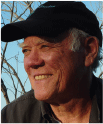Heron8 – The 8th Heron Conference on Reactive Intermediates and Unusual Molecules
Curt Wentrup AA School of Chemistry and Molecular Biosciences, The University of Queensland, Brisbane, Qld 4072, Australia. Email: wentrup@uq.edu.au

Curt Wentrup was educated at the University of Copenhagen (Cand. Scient. 1966 with K. A. Jensen; D.Sc. 1976) and the Australian National University (Ph.D. 1969 with W. D. Crow). After post-doctoral periods with Hans Dahn (Lausanne), W. M. Jones (Gainesville, FL) and Maitland Jones, Jr (Princeton, NJ), a junior position at the Université de Lausanne, and a professorship at the Universität Marburg, he returned to Australia in 1985 as Professor and Chair of Organic Chemistry and Head of the Organic Chemistry Section at the University of Queensland. Now an emeritus professor, he is a Fellow of the Australian Academy of Science, and a recipient of the Centenary Medal of the Australian Commonwealth, the David Craig Medal of the Australian Academy of Science, the Arthur J. Birch and Leighton Medals of the RACI, and a Dr. h.c. from the Université de Pau, France. He works in the area of reactive intermediates using flash vacuum pyrolysis and matrix photochemistry. |
Australian Journal of Chemistry 72(11) 853-855 https://doi.org/10.1071/CHv72n11_FO
Published: 13 November 2019
The Heron Island conferences started in 1991 with an international workshop funded by the Australian Government’s Department of Industry, Technology and Science and the US National Science Foundation. These conferences have now become a regular triennial event enjoying an excellent reputation for high level science, attracting international and national participants, and as such they have become an integral part of the Australian organic chemistry scene. This year, we deviated from the usual venue at Heron Island, holding the conference instead at Ayers Rock Resort in Australia’s red centre (Fig. 1). It was organised by Curt Wentrup and Craig. M. Williams (University of Queensland), and once again, an excellent group of scientists from all over the world attended (Fig. 2). We are pleased to provide a snapshot of some of the science presented in this issue of Aust. J. Chem.
John Maier and co-workers at the University of Basel, Switzerland, report on isotope and temperature effects on the electronic spectra of large carbonaceous molecular ions of interstellar relevance. Several interstellar diffuse infrared bands ascribed to C60+ have been observed recently. Due to the large number of carbon atoms in C60, some of the IR bands may be due to the 13C isotopes. The Maier group has now measured the electronic spectra of isotopologues of protonated coronene in the gas phase at vibrational and rotational temperatures between 5 and 120 K in a 22-pole ion trap. The results demonstrate that 13C isotope shifts of spectral bands of large molecules in the interstellar medium need to be considered.[1]
Mark York, Paul Savage, and co-workers at CSIRO Manufacturing, Melbourne, report a scalable, combined batch and flow synthesis of a bio-inspired, experimental UV-B absorber, a conjugated 3-acyltetrahydropyridine derivative. In the new synthesis of this UV-B absorber, a key step of the process is a one-pot partial reduction of a symmetrical imide with a sequential dehydration step. The preparation relies heavily on the use of continuous-flow steps to increase sample throughput, and in this way quantities of ~0.5 kg in >99 % purity could be obtained.[2]
Anthony J. Arduengo III (University of Alabama, USA) and co-workers in the USA and Japan describe the crystal structure of Burgess inner salts and their hydrolysed ammonium sulfaminates. The Burgess reagent, Et3N(+) SO2-N(-)-COOR, has been widely used, for example, to dehydrate secondary and tertiary alcohols, amides, and nitroalkanes, and to form amines (via carbamates) from primary alcohols. The previously unreported solid state structure of the reagent indicates a triethylamine-solvated sulfonyl imide rather than the usually depicted triethylammonium sulfonyl amidate. The existence of a reversibly formed hydrate of the reagent is not supported by present studies. The hydrolysed ammonium sulfaminates are salts composed of Et3NH+ and O(–)SO2NHCOOR ions.[3]
Philip Wai Hong Chan and co-workers (Monash University, Melbourne) report a gold(i)-catalysed oxidative cycloisomerisation of 1,6-diyne acetates to 1-naphthyl ketones. The proposed mechanism involves cyclopropenation/cycloreversion of the 1,6-diyne motif initiated by a 1,2-acyloxy migration. This is followed by nucleophilic attack of the ensuing gold carbenoid species by a molecule of water and autoxidation to give access to a range of 1-naphthyl ketones. This formation and utilisation of stabilised gold-carbenoid intermediates is of both synthetic and mechanistic interest.[4]
Dasan M. Thammattoor and co-workers (Colby College, USA) describe the photolysis of cyclopropaphenanthrenes as a means to generate carbenes by elimination of phenanthrene. Specifically, exo-1-(1a,9b-dihydro-1H-cyclopropa[l]phenanthren-1-yl)cyclopropan-1-ol and the corresponding cyclobutan-1-ol derivative produce (1-hydroxycyclopropyl)carbene and (1-hydroxycyclobutyl)carbene, respectively. The two carbenes rearrange to cyclobutanone, and cyclopentanone, respectively. This is attributed to ring expansion of the carbenes followed by tautomerisation of the resulting enols.[5]
George Vamvounis (James Cook University, Townsville) and co-workers report an oil spill source identification using colorimetric detection. The colorimetric detection of polycyclic aromatic hydrocarbons (PAHs) was investigated for the quick and easy identification of likely oil spill offenders. Photochromic compounds were used to sense PAHs by varying their photoswitching capacity. To that end, three photochromes were designed and investigated. The response of PAH mixtures that mimic oil spills demonstrated the accuracy of this technology. It is concluded that this may be a viable technique for in situ oil identification.[6]
Craig Williams and colleagues at the University of Queensland report an investigation into 1,2,4-thiadiazole-inspired cyclic peptide mimics. Marine-derived cyclic peptides have cavitand architectures comparable with macrocyclic ligands. Lissoclinamide 5 and ascidiacyclamide are two such cyclic peptides of interest for their metal ion complexation properties and biological activity. Now the stability and potential for copper(ii) ion binding by lissoclinamide 5 mimics are evaluated computationally. One such mimic, 1,2,4-thiadiazole-lissoclinamide, was found to be likely to form a complex with a copper(ii) ion.[7]
Dominik Munz and collaborators (Universität Erlangen, Germany) describe carbon dioxide activation by a palladium terminal imido complex. The group recently reported a palladium(ii) terminal imido (nitrene) complex featuring exceptional nucleophilicity at the nitrogen atom and a peculiar zwitterionic electronic structure with an anti-bonding HOMO. It is now shown that this nucleophilic complex reacts with CO2 to give a ring-strained four-membered palladium(ii) carbamate complex. Remarkably, the same product is obtained in the reaction of the related bisamido complex. DFT calculations indicate that the addition of CO2 does not proceed via initial 1,2-addition across the Pd–N bond, but instead through nucleophilic attack by the imido (amido) nitrogen atom.[8]
Conflicts of Interest
The author declares no conflicts of interest.
References
[1] E. K. Campbell, C. A. Rice, F. X. Hardy, J. P. Maier, Aust. J. Chem. 2019, 72, 856.| Crossref | GoogleScholarGoogle Scholar |
[2] M. York, K. E. Jarvis, J. A. Freemont, J. H. Ryan, G. P. Savage, S. A. Logan, L. Bright, Aust. J. Chem. 2019, 72, 860.
| Crossref | GoogleScholarGoogle Scholar |
[3] A. J. Arduengo, Y. Uchiyama, D. A. Dixon, M. Vasiliu, Aust. J. Chem. 2019, 72, 867.
| Crossref | GoogleScholarGoogle Scholar |
[4] A. T. Holm, S. Nayak, P. W. H. Chan, Aust. J. Chem. 2019, 72, 881.
| Crossref | GoogleScholarGoogle Scholar |
[5] J. D. DeAngelo, S. Hatano, D. M. Thamattoor, Aust. J. Chem. 2019, 72, 890.
| Crossref | GoogleScholarGoogle Scholar |
[6] W. Woodland, R. Lim, C. Motti, P. Irving, J. Wang, M. Payne, P. C. Junk, G. Vamvounis, Aust. J. Chem. 2019, 72, 874.
| Crossref | GoogleScholarGoogle Scholar |
[7] S. Xie, P. V. Bernhardt, L. R. Gahan, C. M. Williams, Aust. J. Chem. 2019, 72, 894.
| Crossref | GoogleScholarGoogle Scholar |
[8] S. J. Goodner, A. Grünwald, F. W. Heinemann, D. Munz, Aust. J. Chem. 2019, 72, 900.
| Crossref | GoogleScholarGoogle Scholar |




